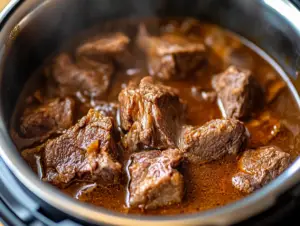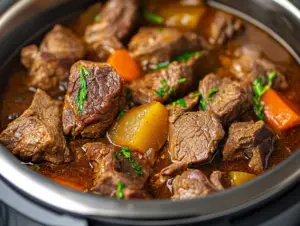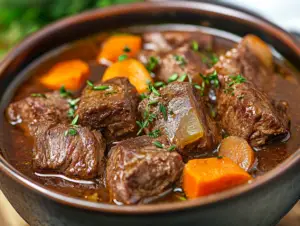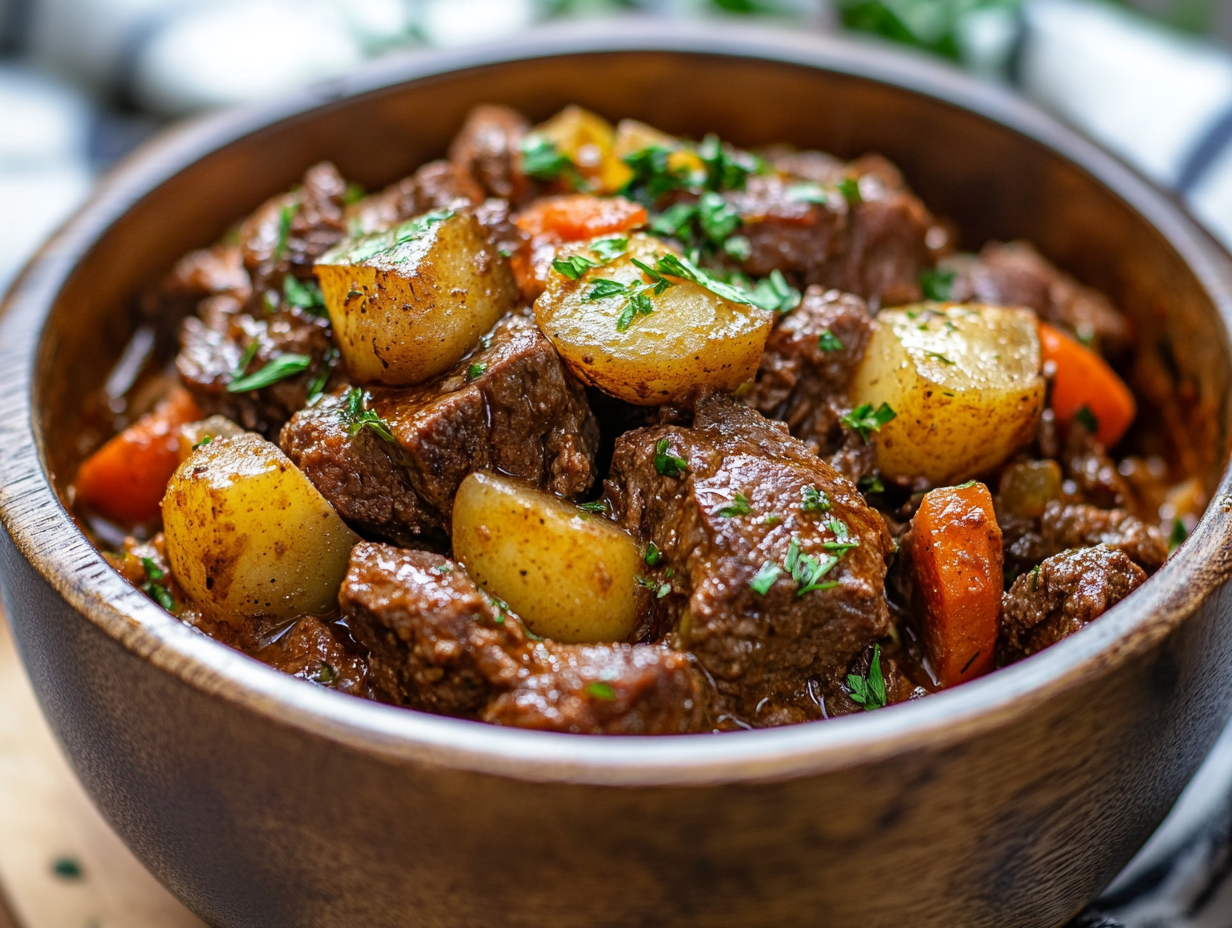The Instant Pot has revolutionized the way home cooks prepare meals, making it faster and easier to cook dishes that would typically take hours. Yet, one common complaint is that stew meat can often come out tough and chewy instead of tender and juicy. This article explores the reasons behind tough stew meat in the Instant Pot and provides practical solutions to ensure your meat turns out perfectly every time.
Understanding the Toughness of Stew Meat
Before diving into the solutions, it’s essential to understand why your stew meat may be coming out tough when cooked in an Instant Pot. There are a few key factors at play:
- Overcooking the meat: While pressure cooking reduces the overall cooking time, leaving the meat in the Instant Pot for too long can break down the proteins too much, resulting in a tough, dry texture.
- Wrong cut of meat: Not all cuts of meat are suitable for pressure cooking. Lean cuts, such as tenderloin or sirloin, don’t have enough fat and connective tissue to break down properly under pressure, leading to toughness.
- Quick pressure release: Using the quick release method for releasing pressure too rapidly can cause the meat to seize up and become tough.
Now that you know the common reasons, let’s explore how to fix these problems and improve the tenderness of your stew meat.
Selecting the Right Cut of Meat
Choosing the right cut of meat is one of the most important factors in achieving tender stew meat in the Instant Pot. The best cuts for pressure cooking are those with more fat and connective tissue, as these will break down into gelatin during the cooking process, creating a rich, tender texture.
Recommended Cuts for Stew:
- Chuck roast: This is one of the best cuts for stew. It has a lot of connective tissue that breaks down beautifully under pressure, making it tender and flavorful.
- Brisket: This cut is also excellent for long cooking times and will result in a tender, juicy dish.
- Short ribs: Although slightly pricier, short ribs offer a perfect balance of fat and meat that works well in the Instant Pot.
- Shank or oxtail: These cuts, rich in collagen, melt into the stew and help thicken the sauce.
It’s essential to avoid lean cuts like sirloin or tenderloin, which are prone to drying out in the Instant Pot. To learn more about the best cuts for slow cooking, take a look at this helpful guide on selecting cuts for slow cooking.
Prepping Your Meat for Tenderness
Properly preparing your meat before cooking can make a significant difference in the outcome. Here are some key preparation steps to follow for the best results:
- Cut the meat into uniform pieces: To ensure that all pieces cook evenly, it’s important to cut the meat into similar-sized chunks, around 1-2 inches.
- Dry the meat: Pat the meat dry with a paper towel before searing it. Removing excess moisture allows for better browning and develops a deeper flavor.
- Sear the meat: Browning the meat before pressure cooking is crucial for locking in flavor and tenderness. Set the Instant Pot to the “sauté” function and sear the meat on all sides until it’s brown. This step also helps prevent the meat from becoming gray and bland.
If you’re still finding that your meat is tough after cooking, try using a tenderizing method like marinading. Marinades with acidic ingredients like vinegar or lemon juice can help break down muscle fibers, making the meat more tender before cooking. You can find more information on how to tenderize tough cuts of meat here.
Cooking Time and Pressure Levels

Another critical aspect of achieving tender stew meat is cooking it for the correct amount of time at the right pressure level. Different cuts of meat have varying cooking times, and understanding these differences is key to avoiding toughness.
General Guidelines for Cooking Times:
- Chuck roast: Cut into 1-2 inch chunks, 35-45 minutes on high pressure.
- Brisket: 45-60 minutes on high pressure, depending on the size.
- Short ribs: 40-50 minutes on high pressure.
- Shank or oxtail: 45-55 minutes on high pressure.
Pressure Level Settings:
- High pressure: This is the default setting for most meats in the Instant Pot. It helps break down connective tissues quickly but can lead to overcooking if not monitored.
- Low pressure: This can be used for more delicate cuts or to avoid overcooking leaner meats.
Always follow recipe guidelines, but don’t hesitate to adjust based on the size of your meat pieces and your desired tenderness.
The Importance of Natural Pressure Release
One of the most common mistakes that leads to tough meat is using the quick release method instead of the natural release method. The quick release causes a sudden drop in pressure, which can make the meat seize up and become chewy.
Benefits of Natural Pressure Release:
- Allows the meat to rest: Natural release gives the meat time to relax and absorb moisture, resulting in a more tender texture.
- Prevents overcooking: Quick release can overcook the exterior while leaving the interior undercooked. Natural release ensures more even cooking.
For the best results, allow the pressure to naturally release for at least 10-15 minutes after the cooking cycle is complete before opening the Instant Pot.
Adding Flavorful Ingredients
The flavor of your stew isn’t just about the meat—aromatic vegetables, herbs, and spices play a key role in developing the rich flavors of your stew. Here are some tips for adding more flavor to your stew while also helping to tenderize the meat.
Aromatic Vegetables:
- Onions, garlic, and shallots: These vegetables not only add depth to the flavor but also release moisture into the stew, helping keep the meat tender.
- Carrots and celery: These are classic stew vegetables that add both sweetness and texture.
- Mushrooms: Mushrooms are excellent for adding umami flavor and can help enrich the broth.
Herbs and Spices:
- Bay leaves, thyme, and rosemary: These herbs work well with beef and add earthy, aromatic flavors.
- Paprika and chili powder: Adding a little heat with spices like paprika or chili powder can bring out the depth in your stew, especially if you’re cooking beef.
- Salt and pepper: Don’t skimp on salt and pepper. Season the meat generously before searing, and adjust to taste during cooking.
For additional umami flavor, try adding a splash of Worcestershire sauce or soy sauce to your stew. These sauces enhance the meat’s flavor and help achieve a richer broth.
Common Mistakes to Avoid

Here are some common errors people make when cooking stew in the Instant Pot that can lead to tough meat:
- Not searing the meat: Searing adds a rich, caramelized flavor to the meat, which can’t be replicated by just pressure cooking. Skipping this step can lead to a flat, bland dish.
- Using lean cuts: As mentioned earlier, lean cuts like sirloin will not break down well in a stew. Stick to fatty, tougher cuts for best results.
- Overcooking the meat: The Instant Pot is powerful, and while it can tenderize meat quickly, overcooking will make the meat tough and dry. Use the recommended cooking times based on the type of meat you’re using.
- Using the quick release method: Always use the natural release method for meat. Quick release causes rapid pressure changes, which can lead to tough, rubbery meat.
Tenderizing Techniques for Instant Pot Stew Meat
If you find that your meat is still too tough even after cooking it for the appropriate time, you can use these additional tenderizing techniques:
- Enzyme-based tenderizers: These include pineapple and papaya, which contain enzymes (bromelain and papain) that break down tough muscle fibers. You can marinate your meat in fresh pineapple or papaya juice before cooking, or add a few pieces to the stew during the cooking process.
- Acidic marinades: Marinating the meat in vinegar, lemon juice, or wine for a few hours before cooking can help break down tough tissues and make the meat more tender. Adding acidic ingredients like tomatoes to the stew can also contribute to tenderness.
- Slow simmering: If your meat is already tough, try simmering it in the liquid for an additional 30 minutes to 1 hour at a low temperature after pressure cooking to further break down the connective tissue.
FAQs on Tough Stew Meat in the Instant Pot
Why is My Instant Pot Stew Meat Tough?
Your stew meat may be tough due to overcooking, using the wrong cut of meat, or releasing the pressure too quickly. Try adjusting your cooking time and choosing a well-marbled cut like chuck roast or brisket.
How Can I Prevent Stew Meat From Becoming Rubbery?
To avoid rubbery meat, ensure you don’t overcook the stew meat. Use the natural pressure release method to give the meat time to absorb moisture and relax. Also, use tougher cuts of meat that break down well under pressure.
common mistakes that lead to tough stew meat in the Instant Pot?
The most common mistakes include:
- Skipping the searing step: Failing to sear the meat before pressure cooking can result in less flavorful and tougher meat.
- Using lean cuts of meat: Cuts like sirloin or tenderloin don’t have enough connective tissue and fat to break down during cooking, which can result in dry, tough meat.
- Overcooking the meat: Leaving meat in the Instant Pot for too long can cause it to dry out. It’s important to follow recommended cooking times for specific cuts.
- Quick pressure release: Quick release causes the meat to tighten and become chewy. Always use the natural release method for stewed meats.
Which cuts of meat are best for the Instant Pot to avoid toughness?
The best cuts for pressure cooking are those with higher fat and connective tissue content. These cuts break down into gelatin and become tender over time:
- Chuck roast
- Brisket
- Short ribs
- Shank or oxtail
These cuts are perfect for long, slow cooking processes, which is why they work well in the Instant Pot.
How can I tenderize stew meat for a more succulent result?
Tenderizing stew meat in the Instant Pot can be achieved by:
- Marinating the meat: Use acidic ingredients like vinegar or lemon juice to break down muscle fibers before cooking.
- Enzymatic marinades: Marinate the meat with pineapple or papaya juice, which contain natural enzymes that help break down connective tissue.
- Natural pressure release: Allowing the pressure to release naturally after cooking helps the meat retain its moisture and become tender.
- Simmering post-cooking: If the meat is still tough, simmer it in the liquid for an additional 30 minutes to 1 hour to further break down tough fibers.

Conclusion
Achieving perfectly tender stew meat in the Instant Pot is all about the right preparation, cooking times, and techniques. By selecting the proper cuts of meat, like chuck roast or brisket, and using methods like natural pressure release and marinating, you can ensure your stew turns out juicy and flavorful every time.
Avoid common mistakes such as using lean cuts or quick-releasing the pressure, and make sure to sear your meat for added flavor. By following these guidelines, your Instant Pot stew meat will be succulent, tender, and packed with rich, hearty flavors.

